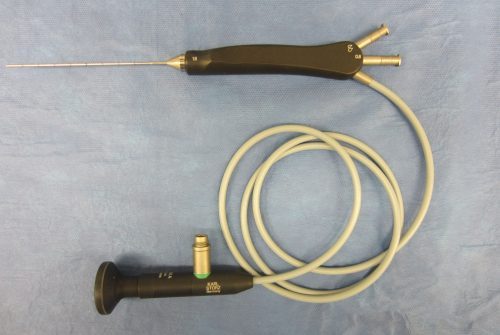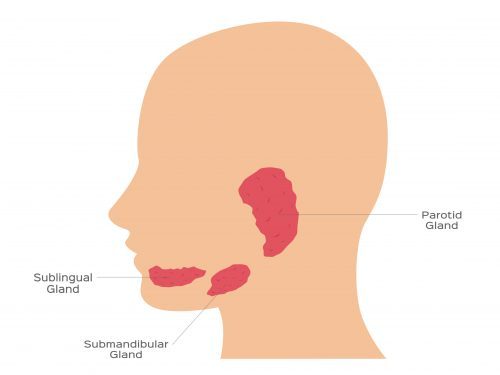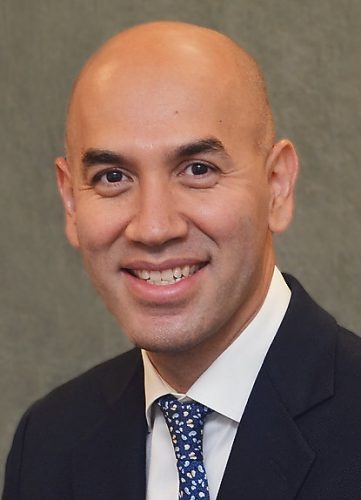A cutting-edge procedure, called sialendoscopy, offers an alternative to surgery for non-cancerous issues affecting the salivary glands, such as stones and other obstructions.
Last month, Mass Eye and Ear became one of a handful of hospitals in the country to perform a procedure called sialendoscopy during an outpatient office visit. This minimally-invasive technique, which diagnoses and treats issues affecting the salivary glands, is more commonly performed in an operating room under general anesthesia. Wais Rahmati, MD recently brought sialendoscopy to Mass Eye and Ear, and Focus spoke with him about it along with which patients might be candidates.
“Sialendoscopy has dramatically changed our approach to obstructive salivary gland disease,” said Dr. Rahmati, a physician and surgeon in the Department of Otolaryngology—Head and Neck Surgery at Mass Eye and Ear. “Patients are able to have the procedure done in the office and leave immediately afterwards, and the recovery can be faster.”
Dr. Rahmati answered some frequently-asked questions about sialendoscopy.
What is sialendoscopy?

Sialendoscopy involves the insertion of a tiny telescope (sialendoscope), through the openings of salivary glands that are found inside the mouth, in order to diagnose and treat various conditions. The sialendoscopes are 0.8 to 1.6 mm in diameter and allow for irrigation (rinsing) of the glands, delivery of steroids and insertion of instruments such as baskets and balloon to treat stones and strictures (narrowing) inside the salivary glands. It is a minimally-invasive and gland-sparing procedure that has fewer side effects than open salivary gland surgery.
With experience and the proper resources in place, we can perform a sialendoscopy under local anesthesia during an outpatient office visit. Unlike usual preparation for surgery in the operating room, patients can eat and drink prior to the procedure and do not need anyone to take them home.
What issues can affect the salivary glands?
 We have three pairs of major salivary glands – the parotid glands, submandibular glands and sublingual glands – which altogether produce up to 1.5 liters of saliva daily. All these glands empty saliva into the mouth through small openings called ducts. If the ducts are damaged or obstructed, people can experience issues with taste, difficulty chewing and swallowing, and an increased risk for other mouth problems such as cavities, tooth loss and infections.
We have three pairs of major salivary glands – the parotid glands, submandibular glands and sublingual glands – which altogether produce up to 1.5 liters of saliva daily. All these glands empty saliva into the mouth through small openings called ducts. If the ducts are damaged or obstructed, people can experience issues with taste, difficulty chewing and swallowing, and an increased risk for other mouth problems such as cavities, tooth loss and infections.
Small stones that form in the ducts may obstruct the flow of saliva causing pain, swelling and infection. Mucus buildup can also cause a blockage. There are some diseases, such as the autoimmune disease Sjogren’s syndrome, which can inflame the salivary glands and cause narrowing of the ducts. Patients with thyroid cancer who have been treated with radioactive iodine may also experience buildup in the salivary glands. Those with these issues may benefit from sialendoscopy, which may also help children with recurrent inflammation of the parotid glands.
What are the symptoms of a salivary gland obstruction that should prompt an appointment?
Salivary gland problems can catch people off guard. Oftentimes, people will have gland pain, swelling and dry mouth, which might result in a trip to the doctor. These symptoms can indicate an infection or happen recurrently around mealtime. Some people experience symptoms for months or years before checking in with a doctor.
A primary care doctor, emergency room, or ENT might be sought out by someone experiencing significant pain and swelling of the salivary gland. For recurrent or complex issues, patients may get referred to a clinic like ours that specializes in salivary gland disorders. Those who are interested may reach out to our clinic directly for an appointment to determine whether they are a candidate for sialendoscopy.
When might a patient need an intervention or surgery?

When the cause of salivary gland swelling or pain is unclear, sialendoscopy may be offered as a diagnostic tool in the office setting. If a problem is identified, it may be addressed right there during the same procedure. For a more complex issue, a trip to the operating room may be necessary. We tailor the treatment to each patient’s preference and unique condition.
For patients with salivary stones, the size and location of the stone will determine the possibility of an in-office sialendoscopy. Stones smaller than 5 mm are generally successfully treated in the office. Sometimes, a small incision is required to release the stone from the duct. For larger stones, the procedure may be recommended in an operating room.
Other salivary gland issues, such as benign or malignant tumors, will require open salivary gland surgery in an operating room. A proper diagnosis can help determine the best course of treatment.
About Our Expert
 Dr. Wais Rahmati is a member of the Department of Otolaryngology—Head and Neck Surgery at Mass Eye and Ear who specializes in endoscopic management of salivary gland disorders. Dr. Rahmati developed one of the largest practices for sialendoscopy in the New York tri-state area before recently joining Mass Eye and Ear. He sees patients at the Main Campus.
Dr. Wais Rahmati is a member of the Department of Otolaryngology—Head and Neck Surgery at Mass Eye and Ear who specializes in endoscopic management of salivary gland disorders. Dr. Rahmati developed one of the largest practices for sialendoscopy in the New York tri-state area before recently joining Mass Eye and Ear. He sees patients at the Main Campus.
Bell’s Palsy on 4/1/19 has left me with dry mouth caused by reduced saliva on one side. Would your procedure be effective on that nerve-related problem?
Hi Elaine, thanks for reading. Diagnostic sialendoscopy may play a role in further assessment of the condition, according to Dr. Rahmati.
I have a problem with dry mouth only on nights when I sleep on my right side. I wake up in the morning with dry mouth. When I sleep on my left shoulder there is never a problem.
Thanks for reading and your comment Alan. Sialendoscopy may not be indicated in this situation, according to Dr. Rahmati.
Would my wife who has dry mouth and dry eyes due to Sjögren’s syndrome be a candidate for this procedure?
Hi Kenneth, thanks for reading. Yes, Sjögren’s syndrome symptoms are indicated for this procedure, according to Dr. Rahmati.
I have dry mouth because of throat cancer radiation treatments. Its been about 6 months since the radiation treatments ended but I still have very dry mouth issues. Could this therapy help<
Hi Maurice, thanks for reading and your comment. If there is recurring gland swelling and pain or concern for a stone – sialendoscopy may play a role. The procedure will not help with radiation related dry mouth, according to Dr. Rahmati.
Would this procedure help someone who has received radiation treatments for neck cancer?
Hi Kevin, thanks for reading. If there is recurring gland swelling and pain or concern for a stone – sialendoscopy may play a role. The procedure will not help with radiation related dry mouth, according to Dr. Rahmati.
I have had a swollen face for over a year. Had combination ear and tooth aches. After several visits with eye,nose and ear specialist and oral surgeons a doctor at Mass Eye and Ear @ 101 Main St. Medford said my problem was sludge in my salivary gland , I was told to gargle with warm salt water apply hot compress and massage from the jaw to chin. I do see a change in my face but when I slow down on the treatment the swelling comes back, Is my condition so minor that the treatment I am doing is the right treatment for me.
Hi Dolores, thanks for your comment and glad you’re seeing some improvement. This issue you reference is a typical indication for sialendoscopy, if you’re interested in an appointment with Dr. Rahmati you can contact his office at 617-573-6113.
Would this procedure help a patient with prolonged dry mouth which has caused thrush infections of the mouth & tooth decay?
Hi Alexandra, thanks for your comment, a clinic visit or virtual visit about your dry mouth might help answer the question on whether the procedure is right for you. Dr. Rahmati’s office can be reached at 617-573-6113.
I would very much like to see Dr. Rahmati for diagnostic reasons. I have been dealing with pain and swelling (not visible externally, just feels that way) since 2015. I have seen many physicians with no concrete diagnosis. I have a long medical record which could be accessed. Please let me know how I could schedule. I will try calling.
Hi Diana, thanks for reading and your comment. You can contact his office at 617-573-6113.
Had parotid problems way back to 1970 ending in 1990’s at ME&E , everyone/tried helped until under Dr. Montgomery it was finally resolved. Wish this technique had been available then !!!
Hi Ernest, thanks for your comment, it sounds like you’ve been through a lot during your time at MEE. Glad everything was finally resolved! Our doctors are always on the lookout for the latest technology for patients when it becomes available.
Have a dry mouth after COVID 19 infection for 3 months that is not resolving. Would I be a candidate for sialendoscopy?
Hi Donna, thanks for reading and sorry to hear. We suggest you call Dr. Rahmati’s office at 617-573-6113, for a consultation.
Would that be cheek inside n out eye close and wrinkles on one side when I awaken or running?
Would that be cheek inside n out eye close and wrinkles on one side when I awaken or running? I had Bell’s palsy thangsgiving
Hi , Diagnosed with stone in Submandibular gland. Two docs want to remove gland. Is Sialendoscopy the best way or surgery. Paul
Hi , Diagnosed with stone in Submandibular gland. Two docs want to remove gland. Is Sialendoscopy the best way or surgery. Paul
Hi Paul, these questions are best answered by a specialist. To set up a consultation with Dr. Rahmati, please call 617-573-6113.
Hi Dr. Rahmati,
I’ve been diagnosed with a 1 cm stone in the submandibular gland. Is a stone this size too large to remove via sialendoscopy?
I have suffered with saliva stones for years and usually could get them out myself. Recently, I had to visit a doctor to get the stone removed from under my tongue. I can feel the sensation that a stone is developing again however, this time it feels like a different location. I’m in New Jersey. Are there any ENT in NJ that can perform the sialendoscopy procedure? Desperately need help!
I had a CT scan about two weeks ago. The results were “very large densely calcified mass aprox 3.4 cm x2.5cm cranial to the submandibular gland near the body of the mandible”. Might I eligible for the procedure ?
I have severe dry mouth due to Sjogren’s disease. Would the saliedoscopy help relieve my symptoms?